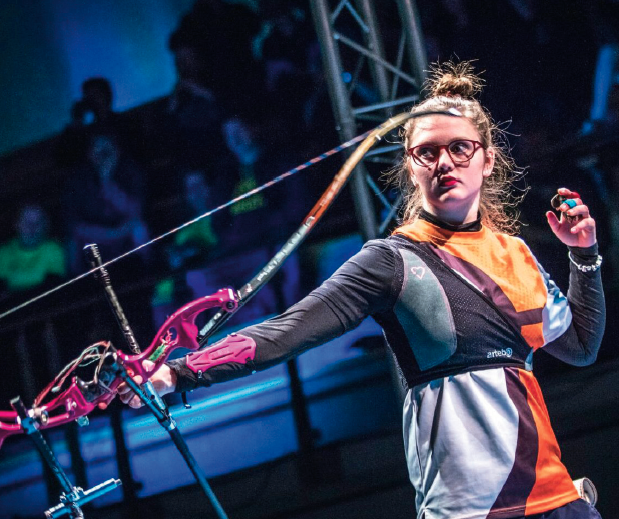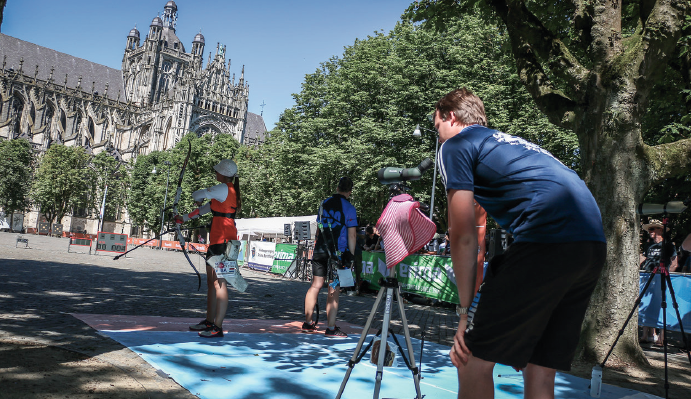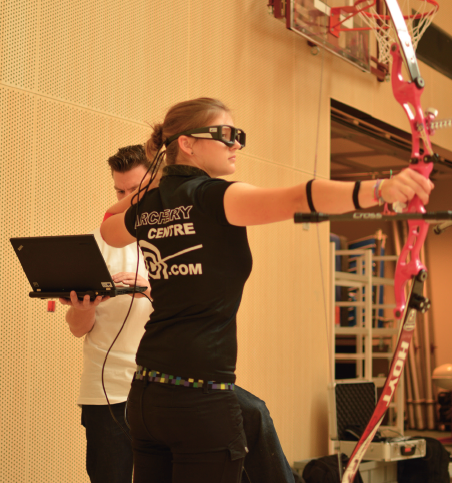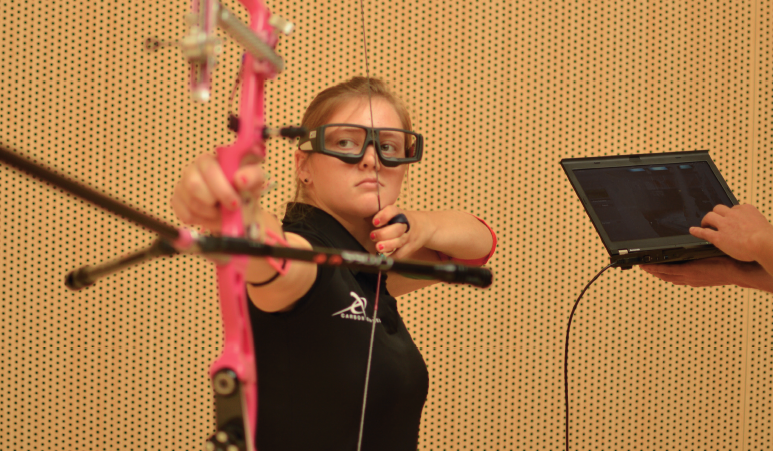
The ideal competition preparation for archers? Claire van Dijck investigates
In the Netherlands, archery has changed a lot over the years. Archery was once known as a sport played in bars, just like darts, but currently there are several regional practice centres and the national team has a full-time programme at Papendal, the Olympic training centre. During competitions emphasis has moved to the elimination rounds where the winner proceeds and the loser is out. The pressure has increased in different ways.
Archery is a precision sport which is dominated by the mind. According to some Korean research 50% of the results in archery are due to mental processes while this is perhaps 20 or 30% for other sports. But not every archer knows how to best prepare themselves for competitions.
One of the most common ways of competition preparation is described by Jake Kaminski in his book. He prepares for international tournaments by reducing the amounts of arrows he shoots and practicing solely on blank bale. There is no hit or miss anymore and he can focus entirely on his technique. However, is this really the best way to prepare for a big competition?
At an international tournament, some archers asked me (in my function as a sports science student) what my opinion was about scoring in practice before an important competition, and what would be the best approach for mental preparation? This is a very important and practical question since as a trainer/coach you want to prepare your archers the best way possible. But how do you do this?
Competition pressure
Normal sports periodisation tends to work towards competition intensity. However the intensity of archery is not a heavy bow or the amount of arrows being shot.
During a standard training session the archer might spend 50% of his/her time on fetching and scoring arrows, but in a competition this might be more like 75%. The intensity of an archery competition is in the mental side of the sport, for example the competition pressure.
This pressure might make the archers focus more on skill-by-skill control, which means that movements which are normally executed in a flow become separated. This might lead to an incomplete follow though without being able to fall back on the trained reflexes.
Competition pressure could be described as every factor or combination of factors that makes it more important to perform well. There are three characteristics for a high pressure situation:
• The result is important
• The result is uncertain, there can be a win or a loss
• The athlete feels responsibility for the results and he/she can be judged upon this result
Research with archers of the Portuguese national team shows that the best scores are achieved when archers are inside of their individual zone of functioning (IZOF), for instance when they are training.
Heightened arousal, like in competitions, can account for archers getting out of that zone and can cause them to significantly perform worse than their normal level. This is sometimes called ‘choking.’
The conclusion can be made that competition and training are psychologically different things, and would suggest that other ways of training could be more helpful than just scoring during training. Reviewing the literature shows three possible interventions to prevent choking: acclimatisation, quiet eye and pre-performance routines.
Acclimatisation
With acclimatisation training the coach tends to replicate the pressure and arousal of competition into training to make the archer familiar with this kind of pressure.
For instance, scientists have tried to replicate the anxiety felt in police officers when they have to shoot someone by training with dummies who would shoot back with coloured paint cartridges instead of the normal cardboard targets they use.
They have also tried to enhance anxiety in darts players by letting them shoot from a 3.25 high platform and in elite basketball players they tried to replicate the arousal with adding ego stressors while taking free balls.

All this research concluded that the effects of the high-pressure situation in the pre-test went away after training under high pressure. Most of the time only four high pressure practices was enough to get this significant result.
Another article about free balls in basketball showed, without empirical evidence, that athletes performed better when their coach put them in a high pressure situation during practice right before competitions.
A mechanism that might be the cause for this, but what’s not noted is that athletes get their confidence when they get pulled out of their comfort zone during training and got used to this situation.
Quiet eye
The retention test in the article with the police officers showed that the officers who trained under pressure looked significantly longer at their targets before they executed the shot than the control group. This is called ‘quiet eye’; which is defined as the last visual fixation on a point within the reach of three degrees from the visual field with a duration of at least 100ms.
In different research the duration of this fixation is seen as an important determinant for performance under pressure: including simulation archery with beginners, free balls in basketball and by shooting with biathletes training for the Olympics.
In all of this research it was found that the athletes who kept performing well under pressure kept the duration of the final fixation the same or extended it with increasing pressure while the control group shortened their quiet eye durations. By increasing the quiet eye duration the cognitive control over the target is being increased.
This might help to reduce the pressure put on the situation. Another cause might be found in the Sechenov phenomenon which states that pain and fatigue are not experienced the same way when you focus your attention on something. It’s like the athletes inhibit their physiological system when they focus their attention on the target.
It is thought the increase of the quiet eye duration in the police officers came from the fact that the men in high pressure situations were forced to only look at the points in space where most information was visible, which is needed to hit the target.
Quiet eye can be trained in different ways. One team created a procedure for training free balls in basketball for Canadian collegiate teams. The procedure had three steps:
• Stand on the line, look at the hoop and bounce the ball 3 times
• Focus the gaze on the hoop for at least 1.5 seconds
• Throw the ball with a fluent movement through the hoop
The experimental group started out the season with the worst scores on free balls and they ended the second season with the highest percentage scored free balls, even higher than the percentages of the NBA.
Pre-performance routines
The last intervention against choking is called the pre-performance routine (PPR). In research conducted in rugby, tennis and bowling the athletes performed better at a post-test under pressure than a pre-test under pressure after using several techniques (for example: modification of optimal arousal level, behavioural steps, attention control and use of keywords). In archery the pre-performance routine is usually called the pre-shot routine.

In research where every shot is being checked with the help of a checklist for the pre-performance routine there were significant improvements after only 20 min of practice.
Although the results are seen pretty fast, it’s better to start early with the formation of a pre-shot routine. This way the archer can adapt this in a way that they can perform it automatically. The Korean team uses this a lot already, they make a mental image of how they grip the bow with their left hand and balancing the forces with their right hand.
They imagine how their arrow hits the middle and tell themselves to do the same again so that they keep the power to do it again. A pre-shot routine can be built using video footage of the shot, using trigger words to regulate the routine, looking for the meaning behind the movements, and reasoning the focus and function of each movement – and practice, of course.
Application in archery
According to the researches on acclimatisation and quiet eye, it is possible to train quiet eye in a direct and an indirect manner. For the direct way, where the athletes are told where to focus, there were already significant improvements within one intervention session. This shows how easily trainable this is and that you can use it quite easy in the pre-shot routine.
However, learning effects are usually more robust when things are learned in an indirect manner. This would mean that acclimatisation would be a good alternative for learning quiet eye. The goal of training like this is that you need a combination of stabilisation and adaptability to perform at competitions. For this reason it’s quite strange to see that Olympic medalist Jake Kaminski trains in a stressless situation before going to a big tournament – but maybe that’s what works for him.
Another example of acclimatization is a study with the Taiwanese national archery team where they used sleep deprivation and simulation to prepare the archers for upcoming competitions. A lack of sleep facilitates a self-fulfilling prophecy: the athletes don’t think they would perform well if they are tired and the cognitive function reduces due to a lack of sleep.

For the competition simulation they used busses to transport the archers to a windy field where the announcements were in English and their friends and family came to watch. Similarly, in the free balls in basketball example the coach chose to train the free balls in a competition format at the end of the training so the athletes would be tired and their bodies would feel differently than during the beginning of the training, just like in competition. The coach would say that the team was behind and they only had a few seconds to win this match.
Archers tend to score significantly worse when their shots last four to five seconds longer than normal. A cause for this might be that the muscle force needed to shoot this longer taking shot is much higher than normal. When the archer feels that this shot is not perfect; e.g. when it is very windy and the sight is moving from the middle, an archer in qualification might chose to not shoot the arrow, come down and try again.
However during a head-to-head finals round, with 20 seconds per arrow, it is not possible to come down anymore. The archer in this situation has to go on and make the best shot possible.
This is easier when the athlete has some experience with shots that last longer than normal. An exercise that could help in this situation would be to elongate the duration of the shot on purpose. If the archer normally takes ten seconds to execute the shot, in a training they could try to make it 15 seconds. Also an in-house competition with punishments and rewards might help to put on extra stress on the athletes.
Important!
If you would like to incorporate acclimatisation training, it is important to present things in a progressive manner, the same way one would do with strength training. The goal of this way of training is to help the athlete be more defensible against pressure rather than ruining the confidence of the athlete.

